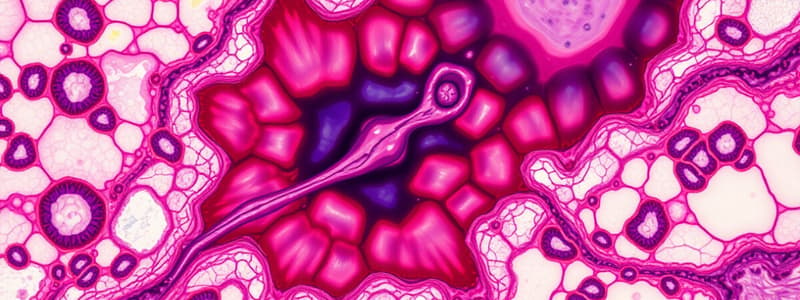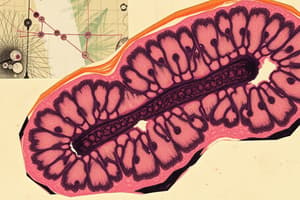Podcast
Questions and Answers
What is histology?
What is histology?
the study of tissue
What are the 4 basic types of tissue?
What are the 4 basic types of tissue?
- Nervous (correct)
- Muscle (correct)
- Connective (correct)
- Epithelial (correct)
What are the 4 major functions of Epithelial Tissue?
What are the 4 major functions of Epithelial Tissue?
- Excretes (correct)
- Protects underlying tissue (correct)
- Secretes (correct)
- Absorbs (correct)
Epithelial cells are tightly packed and not as easily penetrated as other tissues.
Epithelial cells are tightly packed and not as easily penetrated as other tissues.
Describe squamous cells.
Describe squamous cells.
What are cuboidal cells?
What are cuboidal cells?
Describe columnar cells.
Describe columnar cells.
A simple arrangement of epithelial tissue has one cell layer thick.
A simple arrangement of epithelial tissue has one cell layer thick.
A stratified arrangement of epithelial tissue consists of several layers of cells thick.
A stratified arrangement of epithelial tissue consists of several layers of cells thick.
What is a pseudostratified arrangement in epithelial tissue?
What is a pseudostratified arrangement in epithelial tissue?
Describe transitional epithelium.
Describe transitional epithelium.
What is the function of mucous membranes?
What is the function of mucous membranes?
What do glandular epithelia form?
What do glandular epithelia form?
Define exocrine glands.
Define exocrine glands.
Define endocrine glands.
Define endocrine glands.
What are goblet cells?
What are goblet cells?
What is endothelium?
What is endothelium?
What does the term endocardium refer to?
What does the term endocardium refer to?
What is mesothelium/serous tissue?
What is mesothelium/serous tissue?
What is pleura?
What is pleura?
What is pericardium?
What is pericardium?
What is peritoneum?
What is peritoneum?
What is connective tissue?
What is connective tissue?
What is matrix?
What is matrix?
What does loose connective tissue do?
What does loose connective tissue do?
What are the 3 types of loose connective tissue?
What are the 3 types of loose connective tissue?
What are the 3 subgroups of connective tissue?
What are the 3 subgroups of connective tissue?
What is areolar loose connective tissue known for?
What is areolar loose connective tissue known for?
What are fibroblasts?
What are fibroblasts?
What are histiocytes?
What are histiocytes?
What are mast cells?
What are mast cells?
What is heparin?
What is heparin?
What is histamine?
What is histamine?
What is adipose loose connective tissue used for?
What is adipose loose connective tissue used for?
What is reticular loose connective tissue?
What is reticular loose connective tissue?
Describe dense connective tissue.
Describe dense connective tissue.
What are the regular arrangements of fibers in dense connective tissue?
What are the regular arrangements of fibers in dense connective tissue?
What are the irregular arrangements of fibers in dense connective tissues?
What are the irregular arrangements of fibers in dense connective tissues?
What are the components of specialized connective tissue?
What are the components of specialized connective tissue?
What is dentin?
What is dentin?
What are the functions of connective tissue?
What are the functions of connective tissue?
What is muscle tissue?
What is muscle tissue?
What are the three types of muscle tissue?
What are the three types of muscle tissue?
What is smooth muscle?
What is smooth muscle?
What is striated/skeletal muscle?
What is striated/skeletal muscle?
Describe cardiac muscle.
Describe cardiac muscle.
What is nervous tissue?
What is nervous tissue?
What is a neuron?
What is a neuron?
What are the three things that nervous tissue makes up?
What are the three things that nervous tissue makes up?
What is the most highly organized body tissue?
What is the most highly organized body tissue?
Cells divide more rapidly in the ________ and much more slowly in ___________.
Cells divide more rapidly in the ________ and much more slowly in ___________.
Injuries take longer to heal in the young than in older adults.
Injuries take longer to heal in the young than in older adults.
Who are histologists?
Who are histologists?
What do forensic scientists specialize in?
What do forensic scientists specialize in?
What is hyaline cartilage?
What is hyaline cartilage?
What is fibrocartilage?
What is fibrocartilage?
Where is elastic cartilage found?
Where is elastic cartilage found?
What is synovial tissue?
What is synovial tissue?
What are neuroglia?
What are neuroglia?
Flashcards
Histology
Histology
The study of tissues, their structure, and function.
Four Basic Tissue Types
Four Basic Tissue Types
Epithelial, Connective, Muscle, Nervous.
Functions of Epithelial Tissue
Functions of Epithelial Tissue
Forms a protective barrier, absorbs substances, secretes into glands, excretes waste.
Characteristics of Epithelial Tissue
Characteristics of Epithelial Tissue
Signup and view all the flashcards
Squamous Epithelial Cells
Squamous Epithelial Cells
Signup and view all the flashcards
Cuboidal Epithelial Cells
Cuboidal Epithelial Cells
Signup and view all the flashcards
Columnar Epithelial Cells
Columnar Epithelial Cells
Signup and view all the flashcards
Simple Epithelium
Simple Epithelium
Signup and view all the flashcards
Stratified Epithelium
Stratified Epithelium
Signup and view all the flashcards
Pseudostratified Epithelium
Pseudostratified Epithelium
Signup and view all the flashcards
Transitional Epithelium
Transitional Epithelium
Signup and view all the flashcards
Mucous Membrane
Mucous Membrane
Signup and view all the flashcards
Glandular Epithelium
Glandular Epithelium
Signup and view all the flashcards
Exocrine Glands
Exocrine Glands
Signup and view all the flashcards
Endocrine Glands
Endocrine Glands
Signup and view all the flashcards
Goblet Cells
Goblet Cells
Signup and view all the flashcards
Endothelium
Endothelium
Signup and view all the flashcards
Endocardium
Endocardium
Signup and view all the flashcards
Mesothelium
Mesothelium
Signup and view all the flashcards
Pleura
Pleura
Signup and view all the flashcards
Pericardium
Pericardium
Signup and view all the flashcards
Peritoneum
Peritoneum
Signup and view all the flashcards
Connective Tissue
Connective Tissue
Signup and view all the flashcards
Areolar Connective Tissue
Areolar Connective Tissue
Signup and view all the flashcards
Adipose Connective Tissue
Adipose Connective Tissue
Signup and view all the flashcards
Reticular Connective Tissue
Reticular Connective Tissue
Signup and view all the flashcards
Dense Connective Tissue
Dense Connective Tissue
Signup and view all the flashcards
Specialized Connective Tissue
Specialized Connective Tissue
Signup and view all the flashcards
Study Notes
Histology
- Study of tissue.
Four Basic Types of Tissue
- Epithelial, Connective, Muscle, Nervous.
Functions of Epithelial Tissue
- Protects underlying tissue.
- Absorbs substances.
- Secretes into glands.
- Excretes waste through sweat glands.
Characteristics of Epithelial Tissue
- Epithelial cells are tightly packed, minimizing penetration.
Types of Epithelial Cells
- Squamous cells: Flat, protective layer.
- Cuboidal cells: Cube-shaped, found in glands, involved in secretion and protection.
- Columnar cells: Tall, rectangular, often ciliated.
Arrangements of Epithelial Tissue
- Simple: One cell layer thick.
- Stratified: Several layers thick.
- Pseudostratified: Appears layered but extends from basement membrane to free surface.
- Transitional: Flexible, easily stretched, several layers of tightly packed cells.
Mucous Membrane
- Produces mucous, lines body cavities open to outside (digestive, respiratory, urinary, reproductive tracts).
Glandular Epithelium
- Forms various glands.
- Exocrine glands: Lead to outside the body, multicellular with ducts.
- Endocrine glands: Ductless, secrete hormones inside the body.
Specialized Cells
- Goblet cells: Unicellular glands that secrete mucous.
- Endothelium: Lines the circulatory system, including blood vessels.
- Endocardium: Endothelium lining the heart.
- Mesothelium/Serous tissue: Lines internal cavities, reduces friction.
Serous Membranes
- Pleura: Lines thoracic cavity around lungs.
- Pericardium: Covers the heart.
- Peritoneum: Lines abdominal cavity.
Connective Tissue
- Allows movement and provides structural support.
- Abundant intercellular material (matrix) with collagen and elastin fibers.
Types of Loose Connective Tissue
- Areolar: Most widely distributed, assists in injury repair.
- Adipose: Stores fat, provides protective packing.
- Reticular: Forms framework for liver, bone marrow, and lymphoid organs.
Connective Tissue Subgroups
- Loose Connective Tissue, Dense Connective Tissue, Specialized Connective Tissue.
Dense Connective Tissue
- Characterized by tightly packed protein fibers.
- Regular fibers: Tendons and ligaments.
- Irregular fibers: Fascia, joint capsules, muscle sheaths.
Specialized Connective Tissue
- Includes cartilage, bone, dentin, blood, and lymphoid tissue.
Connective Tissue Functions
- Supports, nourishes, transports, connects, aids movement, protects, insulates, stores, and separates tissues.
Muscle Tissue
- Capable of contraction (shortening and thickening).
Types of Muscle Tissue
- Smooth: Involuntary, controls digestive tract movement.
- Striated/Skeletal: Voluntary, moves body by pulling on bones.
- Cardiac: Found in the heart, causes heart contraction, smaller cells.
Nervous Tissue
- Controls and coordinates activities, processes sensory information, and facilitates learning through memory.
Neurons
- Conducting cells that react to stimuli.
Nervous Tissue Composition
- Comprises the brain, spinal cord, and various body nerves.
Tissue Healing Dynamics
- Cell division is more rapid in youth and slower in older adults.
- Injuries heal faster in younger individuals compared to older adults.
Histologists and Forensic Scientists
- Histologists: Study tissues.
- Forensic Scientists: Analyze tissue samples.
Types of Cartilage
- Hyaline: Found in ribs, nose, trachea.
- Fibrocartilage: Found in intervertebral disks.
- Elastic: Found in ears, auditory tubes, epiglottis.
Synovial Tissue
- Specialized connective tissue that lines joints.
Supporting Cells
- Neuroglia: Provide support for neurons.
Studying That Suits You
Use AI to generate personalized quizzes and flashcards to suit your learning preferences.




